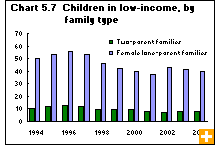Common menu bar links
Fewer children living in low income
Archived Content
Information identified as archived is provided for reference, research or recordkeeping purposes. It is not subject to the Government of Canada Web Standards and has not been altered or updated since it was archived. Please contact us to request a format other than those available.
Over the past few years, the number and share of children living in low-income homes has declined. Some 865,000 children under 18 lived in low-income families in 2004, compared with 1.3 million in 1996. The percentage of children in low-income families fell from a peak of 19% in 1996 to 13% in 2004.
Of the 550,000 lone-parent families headed by women in 2004, 36% lived in low income, down from 56% in 1996. However, these families still include a disproportionately high percentage of the children who live in low-income situations. In 2004, the percentage of children living in low-income families was 40% for lone-parent families headed by women, compared with 8% for two-parent families.
According to a 2006 study based on the NLSCY, children’s well-being is almost always linked to the family’s household income. Regardless of the child’s age or the way the household income was measured, higher income is associated with better physical, social, emotional, cognitive and behavioural well-being in children.
Although the degree of this association varies depending on the characteristics of well-being used, children from higher income households have better outcomes than children from lower income households.
This association holds for all children aged 4 to 15.
The study could not establish the degree of the causal relationship between household income and children’s well-being: income might be a proxy for other family characteristics that affect children.



